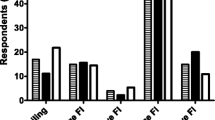Abstract
PURPOSE: Patients with end-stage fecal incontinence in whom all standard medical and surgical treatment has failed or is not expected to be effective can be treated by dynamic graciloplasty. The aim of this study was to review the long-term efficacy data. METHODS: Success was defined as a greater than 50 percent decrease in the frequency of incontinent episodes. Measured physiologic parameters included enema retention time and the difference in resting and squeezing pressures with and without stimulation. Measured quality-of-life parameters included the Medical Outcomes Study Short Form 36 Health Status Questionnaire, a Fecal Incontinence TyPE Specification, the Zung Self-Rating Depression Scale, the “state” portion of the State-Trait Anxiety Inventory, and the Visual Analog Scale, which were administered at baseline and through follow-up. Independent monitors collected data as part of a multicenter trial for patients who underwent dynamic graciloplasty from May 1993 to November 1999. RESULTS: There were 129 patients entered in the study, 115 of whom met eligibility criteria and were included in the efficacy outcome analysis. Twenty-seven patients entered the study with a preexisting functioning stoma; the remaining 88 patients did not have a functioning stoma at the time of enrollment. Success was achieved in 62 percent of nonstoma patients at 12 months; these results were sustained at 18-month and 24-month follow-up assessments (55 and 56 percent, respectively). The success rate in the stoma patients increased from 37.5 percent (9 of 24 patients) at 12 months to 62 percent (13 of 21 patients) at 18 months and was 43 percent at 24 months (9 of 21 patients), which reflects the increased number of patients whose stomas were closed. Although the measured physiologic continence parameters generally improved, these changes did not correlate with continence outcome. The group of patients (stoma and nonstoma) who underwent dynamic graciloplasty showed statistically significant improvements in quality of life as measured by Medical Outcomes Study Short Form 36 physical function (P = 0.006) and social functioning (P = 0.02) assessment. CONCLUSIONS: Dynamic graciloplasty was successful in the majority of patients with end-stage fecal incontinence. This result was usually achieved by 12 months after surgery in patients who did not have stomas and by 18 months in patients who had stomas at the time of dynamic graciloplasty surgery. These various improvements conferred by dynamic graciloplasty persisted during the two-year follow-up.
Similar content being viewed by others
References
JF Johanson J Lafferty (1996) ArticleTitleEpidemiology of fecal incontinence Am J Gastroenterol 91 33–36
DA Drossman L Zhming E Andruzzi et al. (1993) ArticleTitleUS householder survey of functional gastrointestinal disorders Dig Dis Sci 38 1569–1580
D Kumar R Hutchinson E Grant (1995) ArticleTitleBilateral gracilis neosphincter construction for treatment of fecal incontinence Br J Surg 82 1645–1647
AJ Eccersley PJ Lunniss NS Williams (1999) ArticleTitleUnstimulated graciloplasty in traumatic fecal incontinence Br J Surg 86 1071–1072
JM Devesa JM Fernandez Madrid BR Rodriquez Gallego E Vicente J Nuno JM Enriquez (1997) ArticleTitleBilateral gluteoplasty for fecal incontinence Dis Colon Rectum 40 883–888
RK Pearl ML Prasad RL Nelson CP Orsay H Abcarian (1991) ArticleTitleBilateral gluteus maximus transposition for anal incontinence Dis Colon Rectum 34 478–481
WD Wong LL Jensen DC Bartolo DA Rothenberger (1996) ArticleTitleArtificial anal sphincter Dis Colon Rectum 39 1345–1351
J Christiansen OO Rasmussen K Lindorff-Larsen (1999) ArticleTitleLong-term results of artificial anal sphincter implantation for severe anal incontinence Ann Surg 230 45–48
PE O’Brien S Skinner (2000) ArticleTitleRestoring control Dis Colon Rectum 43 1213–1216
RD Madoff CG Baeten J Christiansen et al. (2000) ArticleTitleStandards for anal sphincter replacement Dis Colon Rectum 43 135–141
RD Madoff HR Rosen CG Baeten et al. (1999) ArticleTitleSafety and efficacy of dynamic muscle plasty for anal incontinence Gastroenterology 116 549–556
CG Baeten (2000) ArticleTitleSafety and efficacy of dynamic graciloplasty for fecal incontinence Dis Colon Rectum 43 743–751
SD Wexner A Gonzalez-Padron J Rius et al. (1996) ArticleTitleStimulated gracilis neosphincter operation Dis Colon Rectum 39 957–964
CG Baeten J Konsten F Spaans et al. (1991) ArticleTitleDynamic graciloplasty for treatment of fecal incontinence Lancet 338 1163–1165
SD Wexner A Gonzalez-Padron TA Teoh et al. (1996) ArticleTitleThe stimulated gracilis neosphincter for fecal incontinence Plastic Reconstr Surg 98 693–699
BP Geerdes E Heineman J Konsten PB Soeters CG Baeten (1996) ArticleTitleDynamic graciloplasty Dis Colon Rectum 39 912–917
S Korsgen MR Keighley (1995) ArticleTitleStimulated gracilis neosphincter: not as good as previously thought. Report of four cases Dis Colon Rectum 38 1331–1333
CG Baeten BP Geerdes EM Adang et al. (1995) ArticleTitleAnal dynamic graciloplasty in the treatment of intractable fecal incontinence N Engl J Med 332 1600–1605
NS Williams J Patel BD George RI Hallan ES Watkins (1991) ArticleTitleDevelopment of an electrically stimulated neoanal sphincter Lancet 338 1166–1169
C Mavrantonis SD Wexner (1999) ArticleTitleStimulated graciloplasty for treatment of intractable fecal incontinence Dis Colon Rectum 42 497–504
I Sielezneff AJ Malouf DC Bartolo A Pryde S Douglas (1999) ArticleTitleDynamic graciloplasty in the treatment of patients with fecal incontinence Br J Surg 86 61–65
K Matzel R Madoff L LaFontaine et al. (2000) ArticleTitleComplications of dynamic graciloplasty Dis Colon Rectum 43 13–65
J Konsten CG Baeten F Spaans MG Havenith PB Soeters (1993) ArticleTitleFollow-up of anal dynamic graciloplasty for fecal continence World J Surg 17 404–409
BJ Mander SD Wexner NS Williams et al. (1999) ArticleTitlePreliminary results of a multicenter trial of the electrically stimulated gracilis neoanal sphincter Br J Surg 86 1543–1548
Author information
Authors and Affiliations
About this article
Cite this article
Wexner, S.D., Baeten, C., Bailey, R. et al. Long-Term Efficacy of Dynamic Graciloplasty for Fecal Incontinence. Dis Colon Rectum 45, 809–818 (2002). https://doi.org/10.1007/s10350-004-6302-1
Issue Date:
DOI: https://doi.org/10.1007/s10350-004-6302-1




